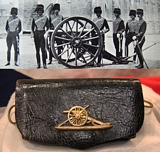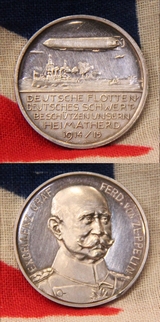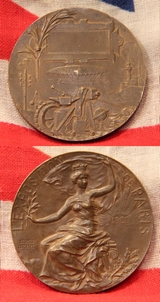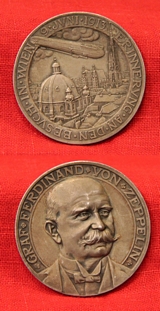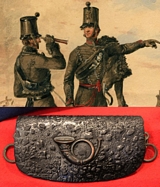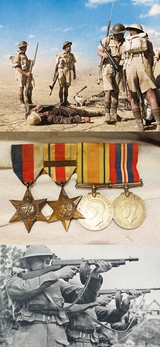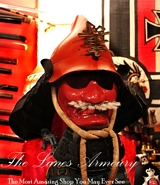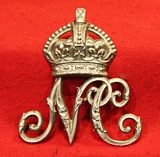Antique Arms & Militaria
French Very Fine Lanthorn Powder-Flask Attributed To Nicolas Noel Boutet
A rare 18th century French flask with a most unusual fold-down nozzle system. With a large, rounded lanthorn body, flattened on the back, with shaped top mount and folding swelling nozzle, reeded brass medial mount, and rings for suspension. For an almost identical example, mounted in silver, see Herbert G. Houze, The Sumptuous Flaske, 1989, pp. 116-117 (illustrated). We also show in the gallery a cased set of the worlds finest flintlock pistols and fowling piece complete with tools and an identical lanthorn flask made by Nicolas Noel Boutet, possibly for Napoleon. This fabulous set is in the Met in New York. We acquired a most similar set, also by Nicolas Noel Boutet, around 50 years ago, that cased set came from a castle in Czechoslovakia, and was commissioned from Boutet for a Prince, that set also had an identical lanthorn flask. Today Iit would likely be approaching a value of a million dollars. Nicolas Noel Boutet was one of the world's greatest gunsmiths, if not The worlds greatest gunsmith, and he made guns for most of the crowned heads of Europe, including Napoleon Bonaparte. He was based at the Imperial Armoury at Versailles. Lanthorn is a transluscent form of ox horn used in the earliest days to make window panes or lanterns. It was the earliest known material for the ingress of light into a room from daylight. In fact the word lantern is a derivative form of lanthorn itself. With lanthorn panes a lantern could be created with a candle to create a portable light and protect the flame from wind. Here are some early instructions as to how it was made; Take the lightest, translucent, hollow portion of an ox or steer horn (these being the thinnest)
Soak this in water for a month
Saw it, split it and press it into plates
Take a short, edge bladed round nosed knive called a "lift" and use it to delaminate the layers (Purportedly up to 12 layers can be gotten from a thick horn).
The Horn may be clarified by coating both sides with tallow, and pressing it between hot irons, thinning it further.
The finished leaves are scraped with steel scrapers, buffed on a polishing wheel, then slightly moistened with vinager and a buffing compound, finally being polished by a buffing compound applied by the palm of the hand (historically the horns were buffed with charcoal and water applied with part of an old beaver hat - the final polish being given by wood ashes applied with the hand). Boutet made several forms of lanthorn flask as its translucent property enable the owner to determine how much powder the flask contained at a glance if held to the light and its resistance to denting was an advantage over copper. A most similar attributed to Boutet flask sold in Butterfield and Butterfield Auction House in San Francisco in 1994 [estimated at 1,500 to 2,500 dollars]. Minor early crack to the lanthorn body read more
950.00 GBP
A Very Good Victorian 19th Century Royal Artillery Officer's Pouch
Patent leather with gilt badge of an artillery cannon. A cross belt is two connected straps worn across the body to distribute the weight of loads, carried at the hip, across the shoulders and trunk. It is similar to two shoulder belts joined with a single buckle at the center of the chest. The cross belt was predominantly used from the 1700s (American Revolutionary War) to the 1840s they were not part of a soldier's equipment in the American Civil War and Anglo-Zulu War/First Boer War.
For most line infantry, skirmishers, light infantry, grenadiers and guard regiments during much of Europe's Age of Gunpowder, either a cross belt or two shoulder belts were worn.[citation needed] One configuration for the belts would be the cartridge box on the right hip and sword scabbard on the left. Such equipment would be attached to the belt at its lowest point, where it rests on the hip. Officers almost never carried muskets or rifles, so they typically wore only one shoulder belt, such as for the pistol cartridge box or for a sabre scabbard. As officers were often aristocratic and used many independent symbols for their family, rank, and command, their uniforms and gear organisation could be highly variable.
For British infantry, the cross belt had a metal belt plate with the regiment of the soldier inscribed on it read more
265.00 GBP
Very Rare German Aerospace Medal of 1915, Part of a Zeppelin Collection
Count Ferdinand von Zeppelin. 1838-1917. AR Aerospace medal. 17.95 gm. 33 mm. By Lauer. 1915. His bust in high relief slightly right / Two Zeppelin airships and one plane above a naval unit in the German fleet at sea; five lines of writing below?1914/15. Hallmarked on edge: SILVER 990. Prooflike Uncirculated; choice; mirror fields; some light marks and hairlines; iridescent toning.
Count Ferdinand Adolf Heinrich August Graf von Zeppelin (1838-1917) was the inventor of the eponymous airship the Zeppelin, the largest number of which were built during World War I and used extensively for reconnaissance scouting and bombing during the war. Another near identical example sold at auction, on the 12th June 2019, in the US for 800 Dollars US read more
585.00 GBP
Bronze L'Exposition de Paris 1900 Commemorative Medal;
Santos Dumont dirigible / airship, Obverse: relief of a robed female figure depicted, embossed text "L'EXPOSTION DE PARIS 1900"
Reverse: relief of electric power lines, Santos Dumont dirigible, and steel battleship depicted. Condition: very good
Dimension: 55mm. Another example is Inventory Number
A19640401000 part of the collection of the National Air and Space Museum, the Smithsonian. Santos Dumont's first airship was his No. 1 (airship) ? First flown on 18 September 1898. Had a cylindrical envelope with conical ends containing a ballonet connected to an air pump: 25 m (82 ft) long, 3.5 m (11 ft 6 in) diameter, 180 m3 (6,400 cu ft) capacity. A square basket was suspended from wooden battens contained in pockets in the envelope, and a silk-covered rudder fitted behind and above the basket. Powered by a De Dion-Bouton tricycle engine (modified to have tandem cylinders) of 3 hp which was mounted outside and in front of the basket driving a small two bladed propeller. Fore and aft trim was achieved by moving a pair of ballast bags. Manoeuvred well, but the ballonet was too small to retain the necessary rigidity of the envelope, and loss of pressure caused it to be wrecked on its second flight on 20 September, from then he made another 10 versions and improvements of it. He also made his first helicopter in 1905 read more
120.00 GBP
Commemorative Medal of Count von Zeppelin Vienna Flight June 1913
Rare special award Commemorative Medal of Count von Zeppelin. We know of just one other example that is in the Smithsonian Space Museum. Medal; Obverse: relief profile bust of von Zeppelin depicted, embossed text "GRAF FERDINAND VON ZEPPELIN"; Reverse: relief of a Zeppelin airship over the Vienna cityscape depicted; embossed text "ERINVERUNG AN DEN BESUCH IN WIEN 9 JUNI 1913". The other, displayed in the Smithsonian National Air and Space Museum, is categorized under exhibit number A19640256000. Size 46mm read more
Victorian Crimean War Period Light Infantry Crossbelt Pouch
Black leather foul weather pouch with coiled horn bugle for the Light Division regiments. Opens to reveal a pouch for despatches and small documents, sovereigns etc. Small leather reataining tab lacking. The Light Division was a light infantry division of the British Army. Its origins lay in "Light Companies" formed during the late 18th century, to move at speed over inhospitable terrain and protect a main force with skirmishing tactics. These units took advantage of then-new technology in the form of rifles, which allowed it to emphasise marksmanship, and were aimed primarily at disrupting and harassing enemy forces, in skirmishes before the main forces clashed.
Formed in 1803, during the Napoleonic Wars, the Light Division was raised thrice thereafter: during the Crimean War, the First World War and from 1968 to 2007. Some light infantry units remained outside the Light Division. A Light Division was again formed for service, but this was in name only as no light infantry battalions were assigned to it. The division was involved in the Battle of the Alma (20 September 1854), which is usually considered the first battle of the Crimean War, took place in the vicinity of the River Alma in the Crimea. An Anglo-French force under General St. Arnaud and Lord Raglan defeated General Menshikov's Russian army, which lost around 6,000 troops. They were also engaged in the Siege of Sevastopol (1854?1855), and the battle of Battle of Inkerman (5 November 1854) before the end of hostilities. read more
265.00 GBP
A Good Original 'Desert Rat' British WW2 British Infantry 4 Medal Group
From a former Desert Rat veteran of the 8th Army. Acquired with his helmet but sold separately. He fought Rommel's Afrika Korps, [who, under Montgomery's command, kicked the DAK's bottoms at El Alamein] and then with the 8th Army transferred to Italy in order to fight from the south right through to Rome, however, the owner of this medal group and helmet was severely wounded before he qualified for the Italy Star medal, however, he did get the Afrika Star with 8th Army bar, plus his other 3 medals. The Eighth Army was a field army formation of the British Army during the Second World War, fighting in the North African and Italian campaigns. Units came from Australia, British India, Canada, Free French Forces, Greece, New Zealand, Poland, Rhodesia, South Africa and the United Kingdom.
Significant formations which passed through the Army included V Corps, X Corps, XIII Corps, XXX Corps, I Canadian Corps and the II Polish Corps. On 26 November the Commander-in-Chief Middle East Command, General Sir Claude Auchinleck, replaced Cunningham with Major-General Neil Ritchie, following disagreements between Auchinleck and Cunningham. Despite achieving a number of tactical successes, Rommel was forced to concede Tobruk and was pushed back to El Agheila by the end of 1941. In February 1942 Rommel had regrouped his forces sufficiently to push the over-extended Eighth Army back to the Gazala line, just west of Tobruk. Both sides commenced a period of building their strength to launch new offensives but it was Rommel who took the initiative first, forcing the Eighth Army from the Gazala position.
Ritchie proved unable to halt Rommel and was replaced when Auchinleck himself took direct command of the army. The Panzer Army Afrika were eventually stopped by Auchinleck at the First Battle of El Alamein. Auchinleck, wishing to pause and regroup the Eighth Army, which had expended a lot of its strength in halting Rommel, came under intense political pressure from British Prime Minister Winston Churchill to strike back immediately. However, he proved unable to build on his success at Alamein and was replaced as Commander-in-Chief Middle-East in August 1942 by General Harold Alexander and as Eighth Army commander by Lieutenant-General William Gott. Gott was killed in an air crash on his way to take up his command and so Lieutenant-General Bernard Montgomery was appointed in his place. Alexander and Montgomery were able to resist the pressure from Churchill, building the Army's strength and adding a pursuit formation, X Corps, to the Army's XIII and XXX Corps.
At the beginning of November 1942 the Eighth Army defeated Rommel in the decisive Second Battle of El Alamein, pursuing the defeated Axis army across Libya and reaching the Mareth defensive line on the Tunisian border in February 1943, where it came under the control of 18th Army Group. The Eighth Army outflanked the Mareth defences in March 1943 and after further fighting alongside the British First Army, the other 18th Army Group component which had been campaigning in Tunisia since November 1942, the Axis forces in North Africa surrendered in May 1943 read more
175.00 GBP
The Lanes Armoury, Probably The Largest Militaria Webstore in The World
Over 15,500 full page colour photographs, with fully descriptive and historical text for each and every original item, for your delectation and perusal. A selection second to none and as varied as one can imagine. Original pieces of history from ancient Persia to Medieval Japan. Covering all of the British, European and worldwide eras of conflict from the past 4000 years, with weaponry, armour, militaria and books from the bronze age to WW2. We have over 30,000 registered regular clientele, and every other daily visitor to our store [we get up to 2500 a day] kindly remarks this is probably the most incredible shop thay have ever seen. The samurai kabuto in the photograph is just one of the beautiful items we have sold in the past. Certificates of Authenticity supplied with every purchase. We issue our certificate of authenticity with every single item purchased, and in regards to our Japanese items, both weapons and fittings etc. We will be detailing its beauty, approximate age, style and feature of its mounts, and potential position in Japanese samurai history. We will detail the translations if known of the signatures on the nakago of swords under the hilt bindings, but purely for information only, many signatures are only representations of the smith or its school, and certainly do not always signify the actual name of the smith that made the blade. Our Certificates of Authenticity are our own version of a lifetime guarantee, detailing the description of its style, age and beauty, and for our Japanese samurai swords in particular, that is is an original, samurai sword, made and used by samurai both ancient and vintage in Japan up to the Meiji era of 1868. read more
Price
on
Request
French Medal Commemorating the Universal Exhibition in Paris,1855. E.Oudine
A large, original, mid 19th century French metal medal of beautiful quality made in 1855. Laureate bust of Napoleon III left. NAPOLEON III EMPEREUR (Obverse by E.A. Oudin?) Reverse: Three allegorical figures. EXPOSITION UNIVERSELLE In exergue: LA FRANCE COURONNE / L'ART ET INDUSTRIE (Reverse by A.A. Caqu?) 6.83 cm diameter. A near identical example in the Royal Collection Trust number;RCIN 444908
AA Caqu? (medallist) and E.Oudine
Napol?on III, Emperor of the French, 3rd son of Lodewyk I, King of Holland (1808-73)
Exposition Universelle (1855 : Paris) Very crisp example in nice condition, two very small edge nicks on the reverse. Exactly ten years before the opening of the first universal exposition in Paris, the future father of the event was serving a lifetime prison term in the state military fortress at Ham. Charles Louis Napol?on Bonaparte, nephew and adopted godson of the Emperor, had failed in his second attempt at a coup d'?tat against the restored monarchy of Louis Philippe. After the first attempt in 1836, the government had exiled him to America. The second attempt in 1840 earned him the detention term at Ham, behind the very walls that, over four centuries before, had held Joan of Arc captive. Many monarchists and conservatives in the Court of Peers and the National Assembly wished for terminal punishment; but the name of Napol?on was in the ascendant once again throughout France. On the very day when Charles Louis was sentenced, Emperor Napol?on's ashes were received by both royalty and the multitudes of Paris with great pomp at the church of Les Invalides. And so, rather than arouse the wrath of the still considerable number of Bonapartists, the Court of Peers determined to make the military fortress at Ham the Elba of Charles Louis. In spite of a decree banning the Bonaparte family from France forever, Charles was elected in absentia to the Assembly. He skillfully parlayed his popularity, and the halo of glory around the name Napol?on, into the presidency of the National Assembly in 1848. After a parliamentary struggle with the retreating forces ? supporters of the monarchy and revolutionaries who wished France to become a republic ? Charles Louis took command of the army and forcibly dismissed the assembly. He was proclaimed Emperor of the French on December 1, 1851. read more
195.00 GBP
Natal Carabiniers Other Ranks Helmet Plate Circa 1901-13. South Africa
Boer war period. A good die-stamped example. Crowned floreated "NC" cypher. Three loops to reverse. VGC. The Natal Carbineers participated in the invasion of Zululand in January 1879, and on 22 January, 23 members of the Regiment perished in the famous battle of Isandlwana. The unit was subsequently relegated to garrison duties at Landman?s Drift on the Mzinyathi, or Buffalo River.
South Africa, 1899?1902
Main article: Second Boer War
In September 1899, the Natal Carbineers were mobilized for active service in the British campaign to subdue the Boer republics of the Transvaal and Orange Free State. The Regiment served until October 1900, when the Natal Volunteer Forces were demobilized. Some men continued their service in the Volunteer Composite Regiment until the end of the war in May 1902.
Ladysmith, KwaZulu-Natal: From 2 November 1899 until 28 February 1900, the bulk of the Natal Carbineers was besieged in Ladysmith, and played a prominent part in that famous engagement. The most prominent military action was the attack by Colonial Forces on the Boer artillery emplacement at Gun Hill on the night of 7?8 December 1899. The Regiment lost heavily from the diseases that ravaged the garrison. A solitary squadron of the Natal Carbineers, the Estcourt-Weenen Squadron, avoided the siege of Ladysmith, and instead participated in the relief operations of Sir Redvers Buller as part of Hubert Gough's Composite Regiment. This squadron?s most notable military action of this period was the disastrous battle of Colenso on 15 December 1899, when four men were killed. These were their most serious losses for any one action during the Anglo-Boer War. Height 3 inches, width 2.75 inches read more
125.00 GBP



